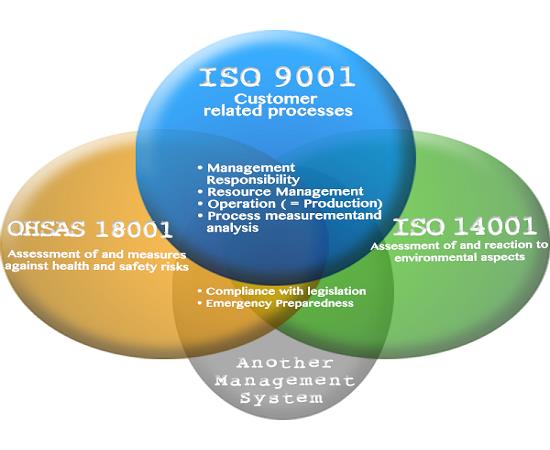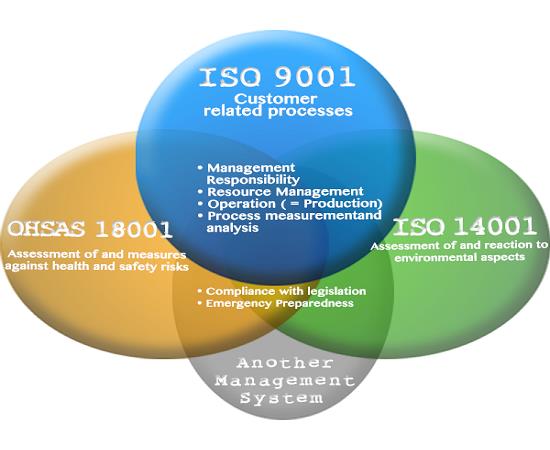
If you’ve ever questioned the need for integrated management system training, here’s an interesting exercise you can do. Simply type ‘integrated management system’ into News on Google and see what comes up. It reveals that Minsk, Iraq, Antigua, Jerusalem, and so many other countries throughout the world are training for, and achieving Integrated Management System ISO 9001 certification.
Increasing important globally, there is every reason to talk to a management system consultant soon and get you on the map.
If nothing else, an integrated management system just makes so much sense! Why try and manage a whole load of different systems when you can put them together and save time and money?
Guidance and tools
The ISO 9000 group of standards covers various aspects of quality management and contains some of ISO’s best known standards. The standards provide guidance and tools for businesses and organizations that want to ensure their products and services consistently meet customer’s requirements, and that quality is consistently improved.
ISO 9001 is the standard that covers Quality Management Systems (QMS) and it was last revised in 2015.
Whatever the size of your business or organization, whatever your industry, you can be certified for ISO 9001 – and more than a million organizations globally have already done that.
A key part of ISO 9001 is ensuring that your systems work, and your business performs internal audits to confirm that.
SMEs taking up challenge
Yearly surveys on ISO management system standards show a steady worldwide increase – and it’s not just large companies making that choice.
Increasingly in Australia, SMEs – small to medium-sized enterprises – are implementing integrated management systems and achieving ISO 9001.
One of the main reasons for this is that they might be supplying large companies that impose strict quality and environmental requirements on their suppliers.
And any business wishing to tender for government contracts will have to go down the same path, as government have strict environmental, quality and sustainability criteria to fulfill.
In most cases, these requirements can only be met by implementing an appropriate management system.
Management systems
All businesses, without even realizing, clearly have management systems, or they wouldn’t be producing and selling products and services. It’s the extent, management and success of those systems that we are looking at here.
A management system consultant will explain how your existing systems can be integrated with new systems with the right training, and how all stakeholders in your business will benefit.
Yes, it costs a little to establish and train, but the long-term cost reductions – not to mention increased efficiency and effectiveness – make it totally worthwhile.
The fact that it also shows commitment to quality, consistency, and employee and customer satisfaction is the reason why large companies expect it of their supply chain.
Maximizing resources
So instead of all these separate systems jogging along at their own pace, you bring them all together with the single aim of improvement.
Reducing risks, maximizing resources, it’s all possible when your management team can make one decision to cover all aspects of the business.
A management system consultant provides businesses with the knowledge and tools to implement and/or maintain their management systems, and achieve and maintain certification.
When choosing a management system consultant, always look for a company that achieves ‘first time’ certification, with Exemplar Global approved courses.
Competitive edge
Smart companies are realizing that combining their health and safety, environmental management and quality systems into one integrated management system is giving them the edge over some of their competitors.
And integrated management system training gives them the knowledge across all those areas to benefit their organization.
But that’s not all. These smart businesses are also enrolling employees on internal audit training courses, seeing the benefits of taking the system one step further.
This is all the more important following last year’s revision of ISO 9001, a change 5 years in the making.
Internal audit training courses cover auditing and reporting techniques, and helps decide what changes and improvements need to be made.
Training is generally provided through a mix of theory and practical workshops, presentations and role playing.
ISO 9001 is all about helping businesses adapt to a changing commercial world. It also establishes the necessary foundations for future growth and sustainable success.
Current legislation
Chair of the ISO sub-committee, Nigel Croft, said the 2015 revision of ISO 9001 brought it firmly into the 21st century, and was more evolutionary than revolutionary.
Less prescriptive than the previous version, it focuses on performance, and has been specially written for easier integration with other management systems.
Importantly, it has brought the Standard into line with current legislation and regulations.
New technology is resulting in higher expectations from customers and from businesses and far more complex global supply chains are coming to the fore. ISO say the only way to successfully manage these challenges is through Integrated Management System ISO 9001.
SEE ALSO: Bo Brower




